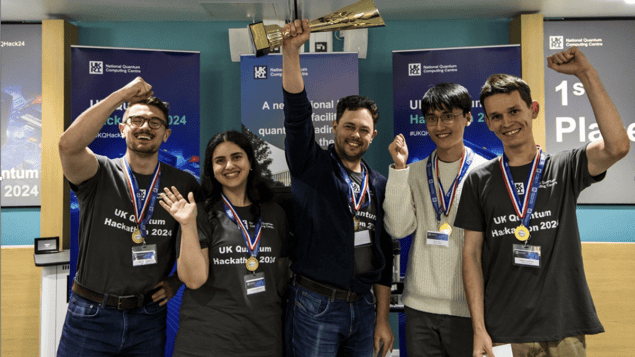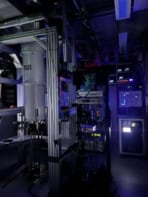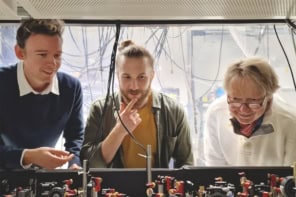With more participants and more use cases across a diverse range of industry sectors, the 2024 edition of the UK’s Quantum Hackathon set new standards for engagement and collaboration

It is said that success breeds success, and that’s certainly true of the UK’s Quantum Hackathon – an annual event organized by the National Quantum Computing Centre (NQCC) that was held in July at the University of Warwick. Now in its third year, the 2024 hackathon attracted 50% more participants from across the quantum ecosystem, who tackled 13 use cases set by industry mentors from the private and public sectors. Compared to last year’s event, participants were given access to a greater range of technology platforms, including software control systems as well as quantum annealers and physical processors, and had an additional day to perfect and present their solutions.
The variety of industry-relevant problems and the ingenuity of the quantum-enabled solutions were clearly evident in the presentations on the final day of the event. An open competition for organizations to submit their problems yielded use cases from across the public and private spectrum, including car manufacturing, healthcare and energy supply. While some industry partners were returning enthusiasts, such as BT and Rolls Royce, newcomers to the hackathon included chemicals firm Johnson Matthey, Aioi R&D Lab (a joint venture between Oxford University spin-out Mind Foundry and the global insurance brand Aioi Nissay Dowa) and the North Wales Police.
“We have a number of problems that are beyond the scope of standard artificial intelligence (AI) or neural networks, and we wanted to see whether a quantum approach might offer a solution,” says Alastair Hughes, lead for analytics and AI at North Wales Police. “The results we have achieved within just two days have proved the feasibility of the approach, and we will now be looking at ways to further develop the model by taking account of some additional constraints.”
The specific use case set by Hughes was to optimize the allocation of response vehicles across North Wales, which has small urban areas where incidents tend to cluster and large swathes of countryside where the crime rate is low. “Our challenge is to minimize response times without leaving some of our communities unprotected,” he explains. “At the moment we use a statistical process that needs some manual intervention to refine the configuration, which across the whole region can take a couple of months to complete. Through the hackathon we have seen that a quantum neural network can deliver a viable solution.”

While Hughes had no prior experience with using quantum processors, some of the other industry mentors are already investigating the potential benefits of quantum computing for their businesses. At Rolls Royce, for example, quantum scientist Jarred Smalley is working with colleagues to investigate novel approaches for simulating complex physical processes, such as those inside a jet engine. Smalley has mentored a team at all three hackathons, setting use cases that he believes could unlock a key bottleneck in the simulation process.
The hackathon offers a way for us to break into the current state of the technology and to see what can be done with today’s quantum processors
“Some of our crazy problems are almost intractable on a supercomputer, and from that we extract a specific set of processes where a quantum algorithm could make a real impact,” he says. “At Rolls Royce our research tends to be focused on what we could do in the future with a fault-tolerant quantum computer, and the hackathon offers a way for us to break into the current state of the technology and to see what can be done with today’s quantum processors.”
Since the first hackathon in 2022, Smalley says that there has been an improvement in the size and capabilities of the hardware platforms. But perhaps the biggest advance has been in the software and algorithms available to help the hackers write, test and debug their quantum code. Reflecting that trend in this year’s event was the inclusion of software-based technology providers, such as Q-CTRL’s Fire Opal and Classiq, that provide tools for error suppression and optimizing quantum algorithms. “There are many more software resources for the hackers to dive into, including algorithms that can even analyse the problems themselves,” Smalley says.
Cathy White, a research manager at BT who has mentored a team at all three hackathons, agrees that rapid innovation in hardware and software is now making it possible for the hackers to address real-world problems – which in her case was to find the optimal way to position fault-detecting sensors in optical networks. “I wanted to set a problem for which we could honestly say that our classical algorithms can’t always provide a good approximation,” she explained. “We saw some promising results within the time allowed, and I’m feeling very positive that quantum computers are becoming useful.”
Both White and Smalley could see a significant benefit from the extended format, which gave hackers an extra day to explore the problem and consider different solution pathways. The range of technology providers involved in the event also enabled the teams to test their solutions on different platforms, and to adapt their approach if they ran into a problem. “With the extra time my team was able to use D-Wave’s quantum annealer as well as a gate-model approach, and it was impressive to see the diversity of algorithms and approaches that the students were able to come up with,” White comments. “They also had more scope to explore different aspects of the problem, and to consolidate their results before deciding what they wanted to present.”
One clear outcome from the extended format was more opportunity to benchmark the quantum solutions against their classical counterparts. “The students don’t claim quantum advantage without proper evidence,” adds White. “Every year we see remarkable progress in the technology, but they can help us to see where there are still challenges to be overcome.”
According to Stasja Stanisic from Phasecraft, one of the four-strong judging panel, a robust approach to benchmarking was one of the stand-out factors for the winning team. Mentored by Aioi R&D Lab, the team investigated a risk aggregation problem, which involved modelling dynamic relationships between data such as insurance losses, stock market data and the occurrence of natural disasters. “The winning team took time to really understand the problem, which allowed them to adapt their algorithm to match their use-case scenario,” Stanisic explains. “They also had a thorough and structured approach to benchmarking their results against other possible solutions, which is an important comparison to make.”

Teams were judged on various criteria, including the creativity of the solution, its success in addressing the use case, and investigation of scaling and feasibility. The social impact and ethical considerations of their solution was also assessed. Using the NQCC’s Quantum STATES principles for responsible and ethical quantum computing (REQC), which were developed and piloted at the NQCC, the teams, for example, considered the potential impact of their innovation on different stakeholders and the explainability of their solution. They also proposed practical recommendations to maximize societal benefit. While many of their findings were specific to their use cases, one common theme was the need for open and transparent development processes to build trust among the wider community.
“Quantum computing is an emerging technology, and we have the opportunity right at the beginning to create an environment where ethical considerations are discussed and respected,” says Stanisic. “Some of the teams showed some real depth of thought, which was exciting to see, while the diverse use cases from both the public and private sectors allowed them to explore these ethical considerations from different perspectives.”
Also vital for participants was the chance to link with and learn from their peers. “The hackathon is a place where we can build and maintain relationships, whether with the individual hackers or with the technology partners who are also here,” says Smalley. For Hughes, meanwhile, the ability to engage with quantum practitioners has been a game changer. “Being in a room with lots of clever people who are all sparking off each other has opened my eyes to the power of quantum neural networks,” he says. “It’s been phenomenal, and I’m excited to see how we can take this forward at North Wales Police.”
- To take part in the 2025 Quantum Hackathon – whether as a hacker, an industry mentor or technology provider – please e-mail the NQCC team at nqcchackathon@stfc.ac.uk




